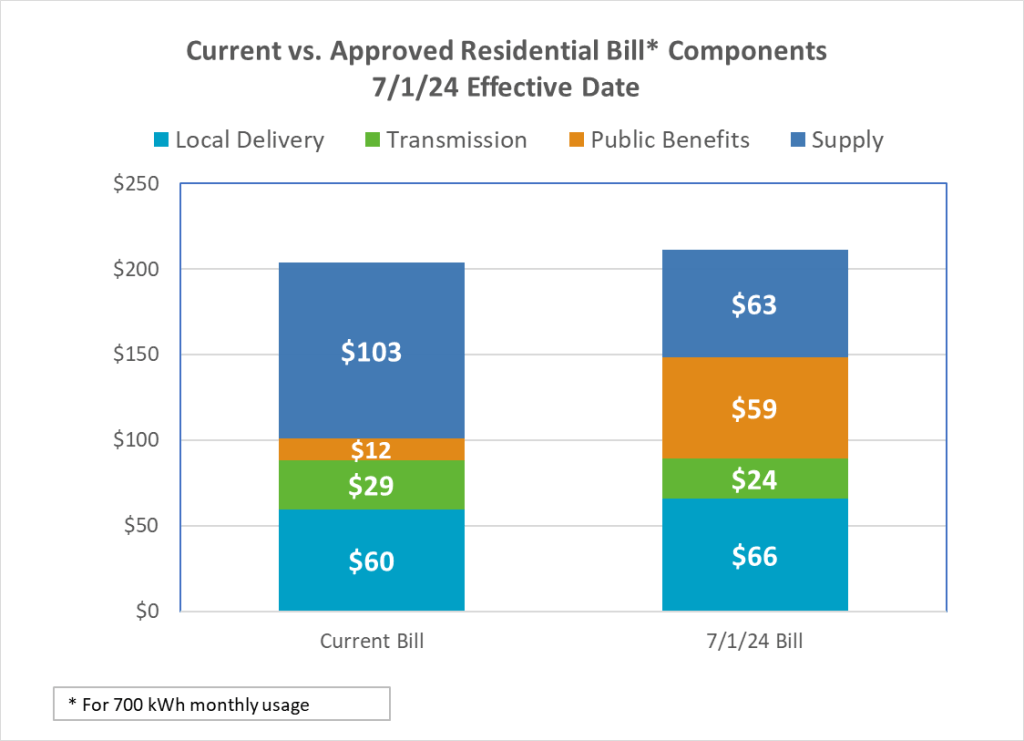There’s been a lot of discussion in the news recently regarding Connecticut electric bills, specifically about what’s changing, how much and why. The majority of Eversource customers will see two significant changes to their bills starting in July, neither of which relates to Eversource’s operations or profits. The “Public Benefits” portion of the bill – which pays for programs and policies required by the state – will increase by about $48 a month. At the same time, the “Supply” portion of the bill will decrease from 14.71 cents per kilowatt-hour (kWh) to8.99 cents per kWh, or about $40 per month. That’s a net increase of about $8 for the majority of Eversource residential customers using 700 kWh per month – lower than initially expected. Eversource advocated for changes with state regulators for more than a year to avoid the sudden and significant increase to Public Benefits.
“Every time bills go up for customers, it is a significant burden. That’s why we collaborated with key stakeholders, and this year proposed aligning the increase to Public Benefits with the decrease of Supply to minimize that impact,” said President of Eversource Connecticut Steve Sullivan. “For more than a year we warned that without regulatory action, our customers would see a large increase on their bill this year from state-mandated contracts, and that’s exactly what’s happening. More work must be done to prevent this kind of rate shock from happening again, and we’ve proposed several solutions for regulators that will create much-needed stability for customers’ bills.”
Supply and Public Benefits now make up nearly 60% of the total bill. These costs can be highly volatile and are not subject to control by Eversource, nor does Eversource make any profit on these items. Less than half of the bill covers the cost of delivering electricity to homes and businesses, including paying for wires, poles, people, training, trucks and the infrastructure. Those costs are far more stable and are necessary to make the electrical system more reliable for customers, improving their overall experience. Ten years ago, the average customer saw their power go out once every ten months, but with consistent investment by Eversource since then, the average customer now goes about 20 months between interruptions, not including severe weather events.
When it comes to energy supply, the utility company follows state law and purchases electricity from power generators and passes those costs on to customers without mark-up. This rate is referred to as “Standard Service” – changing twice a year to reflect market-based cost changes unrelated to Eversource operations.
The Public Benefits portion of the bill pays for many valuable programs to customers, including financial assistance and energy efficiency. The current volatility is almost entirely due to state-mandated power purchase agreements that are also vulnerable to market forces, but can be made more predictable through consistent, thoughtful processes by decision-makers at the state level. Regulators chose to keep Public Benefits costs out of the bill last year, instead authorizing a smaller increase than was needed, leading to a double charge this year. This has created a pileup of costs resulting in the largest single increase ever seen within Public Benefits – an increase not seen by any other state regionally. Think of it like a credit card. If it’s paid off timely, there’s no issue. But if it’s not, the amount adds up. Although it is never easy to pay, it doesn’t get any easier by stalling the payment, because it just causes longer-term harm to customers.
“We have an obligation to serve our customers, which includes ensuring they have the most accurate information about their bill as possible, especially during moments when it affects their business or household budgets,” said Sullivan. “The solutions we’ve proposed to the ratemaking process will better reflect real-time costs and help prevent the kind of rate swings we’re seeing now. We will continue to offer collaboration with the goal of providing predictability for customers.”

